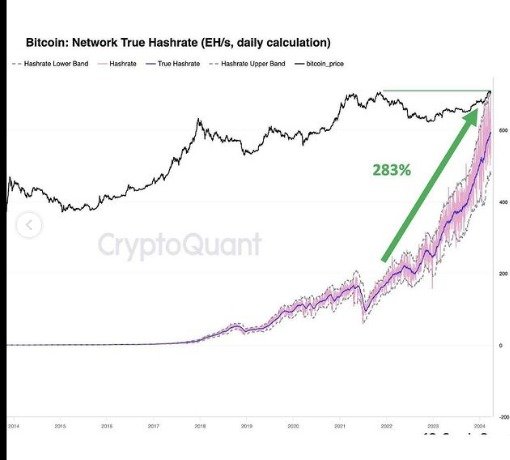
Bitcoin Hash Rate and its Impact on Price
Cryptocurrencies, particularly Bitcoin, have been capturing headlines due to their unprecedented growth and volatility. One of the crucial metrics frequently discussed in the crypto community is the Bitcoin hash rate. In this article, we'll delve into what exactly the hash rate signifies, how it has surged since Bitcoin's last all-time high (ATH), and whether this surge indicates a potential price rally.
- Introduction to Bitcoin Hash Rate
What is Bitcoin Hash Rate?
In simple terms, the hash rate refers to the computational power utilized by miners to validate and secure transactions on the Bitcoin network. It represents the speed at which a miner can solve the complex mathematical puzzles necessary to add a new block to the blockchain.
Importance of Hash Rate in Bitcoin Mining
A higher hash rate implies a more secure network, as it becomes increasingly difficult for any single entity to control the majority of the network's computing power. Moreover, a robust hash rate ensures the smooth functioning of the Bitcoin network and enhances its resistance to malicious attacks.
- Bitcoin's All-Time High (ATH)
Explanation of ATH
Bitcoin's all-time high (ATH) refers to the highest price level ever reached by the cryptocurrency since its inception. Achieving a new ATH is often regarded as a significant milestone and can trigger increased investor interest and media attention.
Recent Growth in Bitcoin's Hash Rate
In recent months, Bitcoin's hash rate has witnessed a remarkable surge, reaching unprecedented levels. This surge is particularly noteworthy as it comes after a period of consolidation and relative stability in the hash rate.
- Impact of Hash Rate on Bitcoin Price
Historical Trends
Historically, there has been a positive correlation between Bitcoin's hash rate and its price. As the hash rate increases, it indicates growing miner confidence in the network's future prospects, which often translates to higher prices.
Correlation between Hash Rate and Price
While correlation does not necessarily imply causation, the relationship between hash rate and price cannot be overlooked. A strong hash rate signifies a healthy and secure network, which is conducive to attracting both institutional and retail investors.
- Fundamentals Driving Bitcoin Price
Supply and Demand Dynamics
Bitcoin's limited supply of 21 million coins plays a crucial role in its price dynamics. As demand for Bitcoin increases, driven by factors such as inflation hedging and store of value properties, its price tends to rise.
Institutional Adoption
The increasing acceptance of Bitcoin by institutional investors, evidenced by major companies and asset managers allocating funds to Bitcoin, has provided a significant boost to its price.
Regulatory Developments
Regulatory clarity and favorable regulations can have a profound impact on Bitcoin's price trajectory. Positive regulatory developments, such as clear guidelines for institutional participation and the approval of Bitcoin exchange-traded funds (ETFs), can attract more capital into the market.
- Factors Influencing Bitcoin's Price Apart from Hash Rate
Market Sentiment
The sentiment of market participants, influenced by factors such as news events, social media trends, and macro-economic indicators, can have a significant impact on Bitcoin's price in the short term.
Technical Analysis
Technical analysis, which involves studying past price movements and trading volume patterns to predict future price movements, is widely used by traders and investors to identify potential entry and exit points.
Macro-Economic Factors
Global economic conditions, including inflation rates, interest rates, and geopolitical tensions, can influence investors' perceptions of Bitcoin as a hedge against economic uncertainty.
- Analysis: Will the Price Follow the Fundamentals?
Recent Trends in Bitcoin Price Movement
Despite the significant increase in Bitcoin's hash rate, the cryptocurrency's price has exhibited a more subdued reaction. This divergence has led to speculation among market participants regarding the decoupling of hash rate from price.
Expert Opinions and Predictions
Opinions among cryptocurrency experts and analysts vary regarding the relationship between hash rate and price. While some believe that the current surge in hash rate will eventually translate into a price rally, others argue that additional factors must align for such a rally to occur.
- Conclusion
In conclusion, the recent tripling of Bitcoin's hash rate underscores the network's robustness and growing miner confidence. While historically, a strong hash rate has been indicative of future price appreciation, other fundamental and market factors also play significant roles. Whether Bitcoin's price will follow the fundamentals remains to be seen, but the cryptocurrency's long-term prospects appear promising amid increasing institutional adoption and favorable regulatory developments.

Unique FAQs
Is Bitcoin's hash rate directly proportional to its price?
While there is a historical correlation between hash rate and price, other factors also influence Bitcoin's price movements.
How frequently does Bitcoin's hash rate undergo significant changes?
Bitcoin's hash rate can experience fluctuations due to factors such as changes in mining difficulty, technological advancements, and shifts in miner sentiment.
Can a decline in hash rate lead to network vulnerabilities?
A significant decline in hash rate could potentially make the Bitcoin network more vulnerable to attacks, although the likelihood of such an event is mitigated by the network's decentralized nature.
What role do miners play in determining Bitcoin's hash rate?
Miners contribute computational power to the Bitcoin network, thereby influencing the overall hash rate. Their participation is essential for maintaining the network's security and integrity.
Are there any risks associated with investing in Bitcoin solely based on hash rate trends?
Investing in Bitcoin or any other cryptocurrency carries inherent risks, and relying solely on hash rate trends for investment decisions may overlook other critical factors influencing price movements.